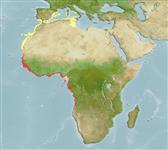Common names from other countries
Environment: milieu / climate zone / depth range / distribution range
Ecology
Marine; brackish; demersal; depth range 10 - 100 m (Ref. 10001). Subtropical; 44°N - 13°S, 18°W - 14°E (Ref. 128784)
Eastern Atlantic: Gibraltar and extreme western Mediterranean southward along the entire west coast of Africa to Angola, near Benguela.
Size / Weight / Age
Maturity: Lm ? range ? - ? cm
Max length : 80.0 cm TL male/unsexed; (Ref. 7059); common length : 55.0 cm TL male/unsexed; (Ref. 2683); max. published weight: 4.3 kg (Ref. 4699)
Common in shallow coastal waters, also in estuaries (Ref. 2683), bays and lagoons, as well as in offshore trawling stations. Feeds on crabs, echinoids and mollusks (Ref. 10001). Occurs over hard substrate (Ref. 5377).
Life cycle and mating behavior
Maturity | Reproduction | Spawning | Eggs | Fecundity | Larvae
Shipp, R.L., 1990. Tetraodontidae. p. 1069-1072. In J.C. Quero, J.C. Hureau, C. Karrer, A. Post and L. Saldanha (eds.) Check-list of the fishes of the eastern tropical Atlantic (CLOFETA). JNICT, Lisbon; SEI, Paris; and UNESCO, Paris. Vol. 2. (Ref. 7464)
IUCN Red List Status (Ref. 130435)
CITES (Ref. 128078)
Not Evaluated
Threat to humans
Harmless
Human uses
Fisheries: commercial; gamefish: yes
More information
Common namesSynonymsMetabolismPredatorsEcotoxicologyReproductionMaturitySpawningFecundityEggsEgg development
ReferencesAquacultureAquaculture profileStrainsGeneticsElectrophoresesHeritabilityDiseasesProcessingMass conversion
Tools
Can't connect to MySQL database fbquizv2. Errorcode: Too many connections
